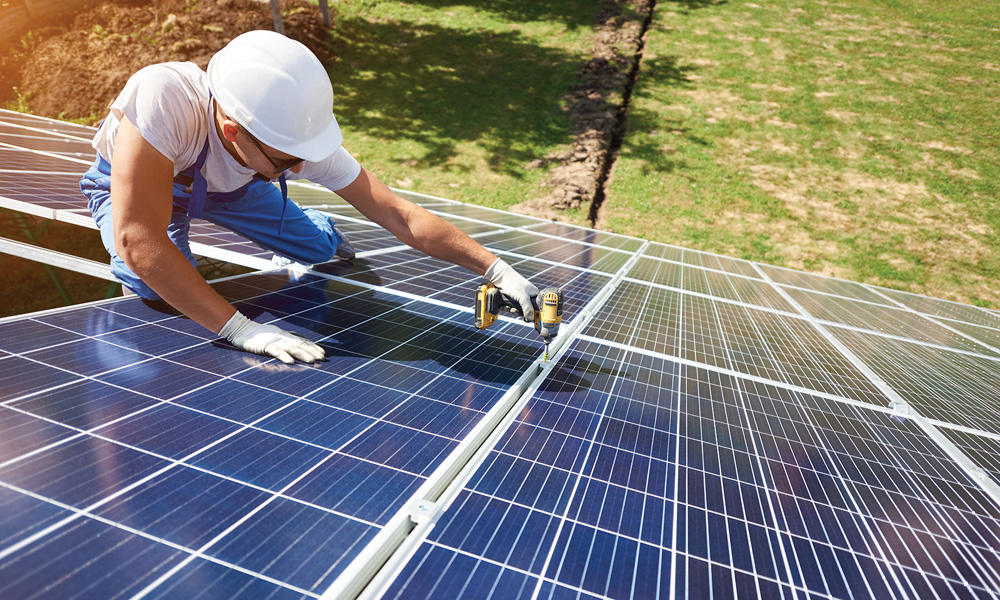March is the time of year when Ohioans are treated to an occasional teasing day of sunshine and warmth before winter reminds us that it’s not done just yet. Still, the blue skies and abundant sun Ohio will get in the next few months may have you thinking about putting that weather to work for you in the form of a home solar array.
There’s a lot to learn about home solar before you sign on the dotted line, though, and sometimes, homeowners get stuck because they don’t know what they don’t know. Fortunately, as a member of a not-for-profit electric cooperative, you have access to an expert you can count on to give you impartial advice — your cooperative energy advisor.
To maximize your solar productivity, ensure that your roof is in good condition and isn’t shaded throughout the day.
We asked a handful of energy advisors from across the state to get us started with some basic information and a few questions to ask as you do your research. All of them agree on the most important step: Contact your electric cooperative before signing any agreement. This is a crucial part of the procedure, not only to ensure that your array is built correctly and properly connects to the cooperative’s system, but also to get an understanding of exactly how solar is going to work for you.
Will solar work on my home?
Bruce Warnecke, energy services advisor at Hancock-Wood Electric Cooperative, emphasizes the importance of a critical evaluation of your home. “Make sure your roof is in good condition first. If you need to replace your roof, that’s going to add to the cost.” Ideally, he says, your roof should face south, but other directions may work as well. “Take a look at the trees near your home,” Warnecke says. “Do they shade the roof? Anything that shades the roof will decrease your energy production, so you might need to look at removing trees as well.”
Additionally, he stresses that this is the time to assess your home for easier, cheaper energy fixes. “It may be more beneficial to improve the envelope of the home to increase its efficiency rather than financing an expensive solar system for many years,” Warnecke says. Ensuring that your home is not leaking any of the air you’ve already paid to heat or cool will provide an immediate return on investment.
Which company should I work with?
“Check their qualifications first,” says Michael Wilson, director of business development and communications at Logan County Electric Cooperative. “Ask about their licenses, insurance, and certifications.” Don’t forget to ask about subcontractors, too — the company installer should be able to tell you what company the subcontractors will be hired from and what experience they have. When it comes to prices, Wilson says, “Get a free quote or bid from multiple contractors to compare, but be sure to look beyond the lowest price; that could be indicative of poor workmanship and bad service.” Wilson stresses the importance of asking for references from previous customers and reading online reviews. Then, he says, ask about their products. “Experienced contractors know their products. Ask what products they carry, how they differ, and which one they’ve selected for your home. If they’ve successfully installed them multiple times before, they’ll know what they’re talking about.”
Will solar save me money on my electric bill?
Ray Crock, energy advisor at Guernsey-Muskingum Electric Cooperative, says, “The short answer is — of course it will save you money on your electric bill. But the real question is whether it will save you money overall, with the cost of solar accounted for.” Crock relates the story of a solar consultation and energy audit he performed a few years ago: “At that time, electricity was costing them about 14 cents per kWh, but the solar salesman told them that price was forecast to rise to 18 cents in five years. Here we are, five years later, and the cost is closer to 12.5 cents. It doesn’t make sense to invest in something that has a 20- to 30-year payback when it will be worn out in 20 to 25 years. My point is to really check the numbers — and have a sharp pencil.”
How much will a solar array cost?
“There are many factors that play into the cost of a solar array,” says Jacob Atkins, energy advisor at South Central Power Company. “One of the contributors of cost is the system size — the larger it is, the more it will cost overall, but it will have a lower cost per watt. The average cost per watt for a system is between $2.50 and $3.50. Another thing to account for is the installer that is putting in the system. Each installer has a different brand of equipment and cost of labor, which will affect the overall price. Also look out for permitting and interconnection fees. The municipality you live in could have permit fees, and your utility could have a fee for interconnecting your array. If taking out a loan, pay attention to the interest rate and associated terms that will impact your loan.”
Can I use batteries to store my energy?
“In a word, yes,” says Chris Bear, energy advisor for North Central Electric Cooperative. But it’s complicated. “You have to install an inverter that will convert the AC power into DC power and then choose where to send the power from the solar panels — either to the house, back to the grid, or to the battery storage system.” He continued, “Battery storage can be installed inside or outside of the structure. The sizing of the battery storage depends solely on the load needed to run. Is the focus on just the minimum household equipment during an outage or running the entire house at any given time? You can add batteries to existing solar arrays, especially if they had the system designed for a future battery backup. It does get more complex if the system was originally not designed for a battery backup.”
Batteries, he says, can last about 7 to 10 years depending on the type and on how often they’re discharged — so replacements should be factored into the overall cost of the system.
What are my co-op’s net billing policies?
“Cooperatives’ rates weren’t originally designed to accommodate solar, and in many cases, rates change,” says Peter Niagu, energy advisor for Paulding Putnam Electric Cooperative. Previously, many co-ops used net metering, which credited members for excess energy at retail costs. That’s given way to net billing, a more equitable system in which the utility, in this case your co-op, pays for the electricity coming from a solar system at the same rate as it would for electricity it generates itself — basically the difference between a retail and a wholesale rate. Niagu cautions to be sure to communicate with the co-op about its policies so you can calculate costs and savings using the proper rate. “There’s a substantial difference between the two main methods of metering,” Niagu says.
There’s much more to learn about home solar, and your electric cooperative energy advisor is committed to making sure you know all you can before your purchase. For even more questions to ask and topics to consider, click here. Then call your electric cooperative to take advantage of one of the benefits of your membership and the fifth cooperative principle of education, training, and information.
Top 10 steps when considering home solar
- Research, research, research, before investing in a solar system.
- Make your home more energy efficient before buying a solar system — it may be a better money-saving option.
- Understand how a solar system meshes with your cooperative’s system — a call to the co-op early in the process is always a good idea.
- Review your current energy use so you can determine what size PV system to install.
- Tally upfront costs.
- Search for incentives, rebates, and tax credits.
- Establish a project partnership between you, your contractor, and your electric cooperative.
- Follow all safety precautions.
- Choose a reputable contractor/installer — check reviews and ask for references.
- Maintain good records, both financial and notes from conversations.













